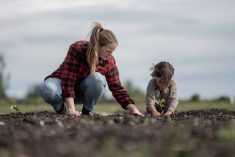With more farmers on the prowl to create new revenue streams, this might be the right time to take a look at an invisible commodity that farmers create simply by doing what they’re already doing.
Alberta has only 10 per cent of Canada’s population, but 40 per cent of our national carbon emissions. With those statistics in mind it isn’t surprising that in 2007 Alberta was the first province to introduce greenhouse gas legislation targeting utilities and other regulated companies known as large final emitters. These businesses can comply with the new law in three ways. They can implement new technologies that reduce carbon emissions. They can pay $15 per tonne into a provincially administered technology and research fund. Or — since those options are complex, expensive and time consuming — they can purchase carbon credits from a third party.
Read Also

Building a farm legacy that outlasts you
A farm’s legacy isn’t just about the land; it’s also about the values and the impact that continue long after the current owner has stepped away.
Enter the farmer.
First, let’s remind ourselves of the biology. Plants fix carbon through photosynthesis. This creates organic matter. As organic matter decomposes it is converted to carbon dioxide which then goes back into the atmosphere. If more carbon is fixed than released, there is a net reduction in carbon emission.
As well, tillage introduces air to the soil, warming it up and creating greater carbon loss. That also means that if tillage is reduced, less CO2 is released into the atmosphere. By adopting reduced and no-till practices, grain farmers are in a position to create agricultural soil sinks. Now they can turn those sinks into a commodity that other emitters are more than willing to pay them for.
Alberta has a number of agricultural carbon offset protocols, but the tillage protocol is the oldest and most used to date. It is designed around the science of soil management.
Graham Gilchrist is with the Farmers Advocate Office (FAO), part of the provincial Agriculture and Rural Affairs Ministry. He says the protocols are based on scientific reviews of total farm research. Individual farms plug their numbers into the resulting formula to determine how many credits they have as a result of a switch to new agronomic practices like zero till or reduced till. These credit numbers are then verified and the credits are sold to large final emitters — mostly utility and energy companies — who use them to offset their emissions.
Sound simple? It’s not. Firstly, individual farmers don’t have enough credits to deal directly with the large final emitters who want to buy them in 100,000- to 500,000-tonne blocks. And secondly, the verification standards require producers “to have a robust data management system to pass the test of limited and reasonable assurance,” Gilchrist says.
The entire agricultural offset system is a dance between large final emitters, farmers, and a buffering agent known as the aggregator. An aggregator puts together large parcels of farm carbon credits which are verified by a third party as having met the protocols. When the credits are deemed to be valid, they are then serialized and put on a provincial registry. At that point they are available for sale, with the aggregator negotiating the price.
But we’re not done yet. Two years after the aggregator has bought your credits and sold them to a large final emitter, a government audit is conducted going right back to the original farm data. When a letter is received by the aggregator indicating that a certain pool of credits with a certain serial number is valid, “only then is the transaction absolutely complete,” says Bill Dorgan, president with AgriTrend Aggregation Inc. (ATAI).
You might be forgiven for wanting to toss up your hands and say “thanks, but I’ll pass.”
Before you do, here are some statistics. According to the FAO, 4.2 million tonnes of CO2 credits have been accumulated and retired by final emitters from tillage offsets since 2007. That’s $60 million trading via roughly 25,000 parcels on the registry by 2010. If you had a section of land in the market for 10 years, at $2,500 per quarter, that’s $10,000 on the table.
There’s money to be made, but if producers want to play in this market, they have to have the data management and agronomic practices to enter the playground.
“The final product is just data,” Dorgan says. “…compliant quality data.”
That data collection starts on the farm. When ATAI’s carbon coaches meet with farmers they are looking for exact, precise and accurate information. They then convert that data into an offset that has value. Farmers then sign off that the generated data is true.
“This is the law,” Dorgan says. “It’s not just a program.”
While it is law, with protocols spelling out the details, there is no official list of verifiers, only guidelines indicating that a verifying team should include a professional engineer and a chartered accountant, which leaves it up to the aggregator to choose qualified and capable verifiers.
“There is a lot of risk to the aggregator,” Dorgan says. “We have to make sure they verify to standards they understand.”
Once a contract is signed with the grower, title to the offsets is relinquished to the aggregator. ATAI buys offsets for a dollar, Dorgan says, with trailing income post-sale. While each aggregator contracts differently, ATAI takes a percentage of gross sales, generating their fees out of the reconciliation of the sale.
Because the legislation sets the value of credits at $15, that’s where the value caps out. And while Dorgan says the carbon market does not make ATAI profitable as a stand-alone AgriTrend entity, it is a useful tool for their agronomists out in the field, providing an additional service to farmers.
And for the farmer? “It’s a new revenue stream not impacted by weather,” Dorgan agrees. “It is steady, stable and predictable.”
It is also recognition of environmental responsibility. “This is nothing more or less than a reward for being a good steward,” Dorgan says. “It is also an opportunity for a grower to get the data history of his land.”
While these advantages might exist, at the FAO, Gilchrist has some cautions for farmers. He sees three areas in which they need to be well versed and aware.
• COMPLIANCE
- COMPLIANCE
There are five main areas of evidence required for compliance under the Alberta tillage protocol. There needs to be proof there was a crop and proof of the true farm acres converted to no till. As well, farmers must also document use of the correct tillage instruments including the required spacings and number of passes. They must adhere to different calculations applicable to dry prairie or parkland zones, and indicate a clear line of ownership. With 40 to 50 per cent of land farmed by tenants, this last one can be a big stumbling block.
“The landowner has the sink right, the farmer has the data right and they need to agree to create a credit,” Gilchrist says. “A handshake isn’t enough. You need a written agreement laying out a clause about carbon offsets. You need to be able to connect the final emitter back to the source of the tonne.”
Some landowners waive the right to the credits in favour of the tenant who is, after all, making the farming decisions and keeping the data. Others want the money, while still others will split. Both Dorgan and Gilchrist agree the carbon offset must become part of land transaction and land-leasing agreements because without the landowner’s signature, nothing can happen.
• CONTRACTS
- CONTRACTS
“This is not a government program,” Gilchrist says. “It is a commercial enterprise, a sale between a power producer and a farmer.”
The FAO became involved in the agricultural offset world when approached by farmers concerned about the contracts they were signing. Their goal has been to assure quality of the product and transparency of pricing for farmers. They’ve had some success, managing to get in early in the process with industry and farmers to help set some standards. “It’s not as tight as some farmers would like, but now they have an appeal process as well,” Gilchrist says.
There are basically two kinds of aggregators, those who purchase directly from the farm and those who act as agents. It’s pretty obvious which Gilchrist prefers.
“Purchase agreements are clearest,” Gilchrist says. There are two types: outright purchase which might provide a lower price but is guaranteed, or share purchase which provides an amount up front followed by a percentage of final net. “As an ag economist I feel having the cash up front is always better.
“We have concerns with some agency agreements where the fiduciary duty between agent and seller is not clear,” Gilchrist says. “They are undefined and open ended.”
In either case, the FAO counsels farmers to be prepared, to know what they’re signing and to get help if they need it. To this end the FAO website has an extensive list of questions a farmer should ask about before signing a contract. It also sets out examples of producer favourable clauses for both purchase and agency agreements, and it asks industry and aggregators to use “plain English” in their documents.
• RISK
- RISK
“Have we weeded out all the unscrupulous dealers? No,” says Gilchrist. “It’s difficult to know without transparency.”
The final risk in this whole game rests with the final emitter because companies are on the hook to produce something to Alberta Environment every year, Gilchrist says. But the risk to the farm is the lack of pricing transparency, something his office has been advocating for.
“It is a bilateral market,” Gilchrist says. “You can’t gauge on a price basis whether you are getting a good or bad contract.” In a transparent market exclusive deals between aggregators and companies would be evident and others would know the resulting discount. As it stands now, there is a 40-cent spread in the aggregator’s cut on the sale of credits, with unique price quotes from each of the aggregators, according to FAO information.
• GOING FORWARD
- GOING FORWARD
As of January 2011, new Alberta legislation is only allowing carbon credits on a forward basis, which means no more historical data. And because the Alberta auditor general’s most recent report asked for stronger evidence of verification, all credits will now be verified using reasonable assurance. That’s the same standard as a full financial audit.
Data collection and verification will presumably become more expensive, so the business model used by aggregators may change again.
The Alberta tillage protocol and resulting carbon market for farmers is only one type of agricultural offset but it shows the complexity of the legislation and its requirements. In the meantime other provinces are looking at the Alberta model to design their own legislation and offset systems. In a world where ecological goods and services are increasingly part of common language this may be only a starting point for agriculture.
THE ALBERTA STORY
Alberta has led the way in greenhouse gas legislation, with mandatory emission reduction levels for industry and carbon offset protocols to help companies meet those targets. Many of the protocols target agriculture and present a unique, if complex, opportunity for farmers to enter the carbon credit market and be financially rewarded for good stewardship.
Alongside tillage, Alberta has more recently adopted protocols around beef, dairy, and pork production, as well as agroforestry. All are developed through scientific research and most are a simple recognition of what producers have been doing all along: adopting new and existing technologies that cut costs by saving time, fuel, feed and other inputs.
That the production decisions happen to produce carbon credits can be seen as a bonus.
Graham Gilchrist with the Farmers Advocate Office in Alberta cites the example of ear tags used in the livestock industry. They were introduced to address traceability concerns, but the fact that they also provide real birthdates has allowed for a beef protocol to be developed. Early slaughter generates a certain number of carbon credits and the tag, with that birthdate, becomes part of the verification process.
Saskatchewan has been working on its own greenhouse gas legislation. While Environment Minister Dustin Duncan did not respond to our request for an interview, the legislation is expected to be closely linked to that in Alberta.
Bill Dorgan, president with AgriTrend Aggregation Inc. (ATAI) says his organization has been to several meetings with government and stakeholders in Saskatchewan and expects legislation and protocols to be similar.
Two years ago Ontario’s Agriculture Ministry conducted a pilot project with 21 Ontario farmers to test the data collection, management requirements, and verification components of tillage protocols. They found that despite differences in soil type, crop rotations and fewer summerfallow acres in Eastern Canada, the reduced or no-till protocol would work.
According to correspondence from senior communications adviser, Susan Murray, other agricultural practices show promise to mitigate emissions and/or sequester carbon on Ontario farms. They include anaerobic digestion of manure, reduced application of fertilizers, cultivation of perennial biomass crops such as tall grasses and short-rotation woody crops, and practices to retain and manage farm woodlots and hedgerows.
Ontario’s work hinges on the development of “a cap and trade system that will work for Ontario,” according to Murray. To that end they are working closely with the Western Climate Initiative (WCI).
WCI is a collaboration of independent jurisdictions working to identify and implement emissions trading policies at a regional level. Its members include British Columbia, California, Ontario, Quebec and Manitoba. Beyond that it is part of broader efforts with some western, midwestern and northeast states.
That’s a pretty big region, making it more like a North American initiative without the participation of federal governments. But maybe that’s the way it will have to be done. Back in Alberta, Gilchrist says the federal policy to police emissions as opposed to implementing a cap and trade policy, has left the provinces to figure out how to adapt to attain their goals.
But Gilchrist also sees the effects of environmental efforts moving agriculture way beyond carbon credits and their incidental benefits.
Is Wal-Mart watching?
“It’s a good first look at how environmental goods and services would trade,” Gilchrist says of Alberta’s foray into the carbon offset market. “The interaction of the offset is a consequence of planning that we can participate in, but it wasn’t designed as an environmental effort within agriculture.”
In other words, farmers are finding out if they qualify as opposed to looking for ways to qualify. “There is a crossover in the use of technology for good management which allows for data which can be used for assurance evidence,” Gilchrist says. This then creates credits. But he sees a different scenario coming down the pipes, one imposed by commercial considerations.
If, for example, Wal-Mart requires evidence that a farm is ecologically sound before buying product from that farm, “it means another binder on the shelf,” Gilchrist says. That binder might need to include, for example, data on power consumption. On a large, multiple enterprise farm, that might mean submeters would be required in order to calculate credits. “It also means you may not or cannot sell your product without that binder.”
Or perhaps the supply-managed sector will not allocate quota without evidence of a food safe system because that is what is required by the end buyer. Gilchrist cites a Japanese beef company that imports Alberta barley but requires paperwork and verification of all production practices related to their barley.
“As ecological goods and services start to exist in real form there will be a need to conform as a farm if you want to play in that market,” Gilchrist says. “In those markets you will have to have the data and the systems.”
Gilchrist believes farmers will adapt. “It’s no different than in ’07 when Alberta said ‘there shall be offsets.’ Everyone just had to figure out how to do it.” CG














